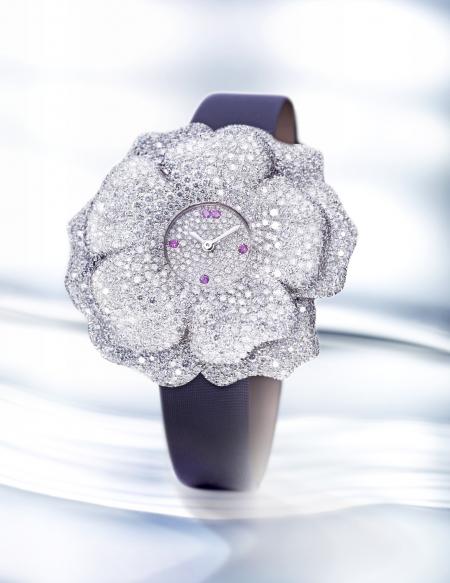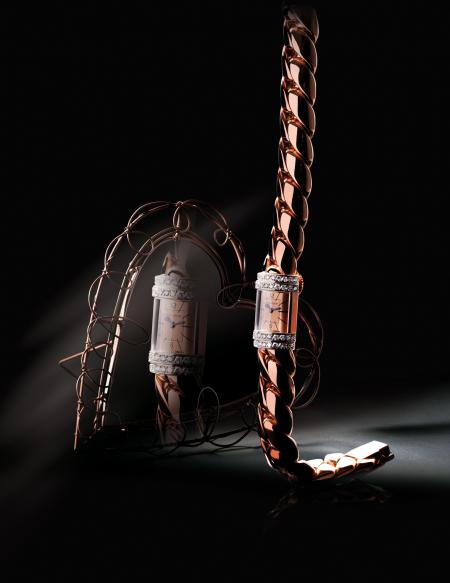The new Montre Extraordinaire La Rose : a brilliant illustration of the Jaeger-LeCoultre jeweller expertise
By MyWatch
Jaeger-LeCoultre has enriched this tradition by creating “secret” watches with covers, as well as swivelling and pivoting models, rings and pendants, covering a range of styles stretching from the purity of Art Deco to the most expressive floral motifs. Radiating ultimate aesthetic appeal and supreme elegance, these creations unite the twin arts of exceptional watchmaking and fine jewellery. Such masterpieces could only be created in the workshops of the Manufacture that so fully masters the subtle intricacies of mechanical perfection and the most exquisitely delicate gem-setting techniques.
After its 2007 launch at the Venice International Film Festival, La Montre Extraordinaire La Rose is blossoming this year in a sparkling version lighting up the wrist with over 14 carats of diamonds. Its delicate curves are inspired by the 19th century, and its finely relief-worked bloom sculpted in white gold is entirely covered with precious stones accentuating the finesse and the lifelike motion of the layered petals. Born from the expert fingers of genuine artists, this Haute Joaillerie model weds beauty and precision thanks to the most complex of all gem-setting techniques: snow setting.
Within the workshops of the Manufacture, gem-setting is a discipline exercised as an art in its own right. Not only do they master all the customary gestures involved in their craft, but the Jaeger-LeCoultre gem-setters have themselves developed procedures in order to meet specific aesthetic demands. Invented by Jaeger-LeCoultre, snow setting calls upon all the artisan’s expertise in order to achieve this voluptuous, frosted effect that is truly unique in its kind. With the model itself as the only point of reference, the craftsman’s work is gradually revealed as the closely nestled stones progressively carpet the entire metal surface. In addition to the complexity of the task and the time required to perform it, the prior selection of the diamonds also calls for considerable expertise: the smallest diameters must be able to merge seamlessly into the most daring shapes – as in this particular instance where the petals provide no flat surface whatsoever. The rose is covered with a total of 1,420 diamonds. Working with an extremely broad palette of individually cut and adjusted stones, the master gem-setter fits them closely side by side, playing with the varying diameters, and little by little this fine workmanship entirely covers the white gold of the case and dial. The latter is demurely swept over by a pair of hands and punctuated by pink sapphires symbolising the precious and transcendent nature of time. Finally, such extraordinary gem-setting is matched by an exceptional mechanism: the manually-wound Jaeger-LeCoultre Calibre 846 which lies hidden at the heart of this sparkling floral creation.
Historical expertise
Over the centuries and in step with changing dress codes, women have determined the aesthetic of time and the ways in which it is worn. They have adopted all manner of innovations and horological complications. They have combined beauty and perfection, thereby enabling watchmaking to draw nurture from the art of jewellery and goldsmithing. Whether hung from a long sautoir necklace, attached to the belt by a “châtelaine” chain, concealed within a brooch or a snuffbox, watches have displayed the multiple, ever-changing and secret facets of their nature – very much like women themselves. And when 18th and 19th century customs held that ladies had no need to measure time or to enquire about the time when in company, the dance of the hours was delicately cloaked in pearls and precious stones.
Jaeger-LeCoultre has always lavished special attention on feminine timepieces, in terms of both their aesthetic and their mechanism. In particular, this tradition dates back to the smallest round movements with an extremely small diameter, such as the LeCoultre Calibre 7HP created in the 1880s, and which equipped enamelled watches set with diamonds and pearls, generally worn around the neck.
The 19th century saw the emergence of the wrist bracelet. Contrary to a commonly held belief, the first wristwatches were worn by women, before being adopted by men who had maintained a longstanding preference for the perceived masculine elegance of pocket-watches. The sleeveless Regency and Empire style dresses of the period uncovered both arms and wrists, thus inciting jewellers to adorn the areas thus revealed. Some had the idea of incorporating a watch mechanism inside. This marked the birth of the first wristworn watches, individually crafted to order, and exclusively inspired by a jewellery-oriented approach.
At the time, the most refined round calibres by Jaeger-LeCoultre hid the winding-crown beneath the watch, so as to preserve the perfect purity of the circle shape. Firmly attached to the precept of product integrity according to which a movement must follow the contours of the case housing it, the Manufacture soon became a specialist of so-called “form” movements, meaning all those with shapes other than round. In 1908, the LeCoultre Calibre 6EB movement drove some of the first ladies’ wristwatches. This square mechanism measured barely over one centimetre along each side and a mere 1.5 mm thick. The watchmakers of the Manufacture displayed boundless creativity in devising rectangular, “tonneau” (barrel), baguette or almond-shaped movements. The brand’s dainty Art Deco style watches were entirely in tune with the spirit of feminine emancipation characterising the Roaring Twenties and infused with a determination to break free of existing conventions.
It was within this context that the Duoplan watch was introduced in 1925.
The LeCoultre Calibre 7BF Duoplan effectively reconciled two factors formerly perceived as two sworn enemies in the field of watchmaking: miniaturisation and precision. Interpreted in countless different ways, fitted with satin or leather straps, crafted in steel or gold and set with diamonds or rubies, the Duoplan watch could be transformed at will into a brooch watch or a “secret” watch with a special cover, soon becoming the very symbol of femininity. The winding crown was even hidden beneath the case to as to ensure perfectly balanced smooth lines – witness in particular the delightfully graceful, elegant silhouettes of the so-called “tuiles” (tile) versions. Duoplan was greatly appreciated among women and particularly in the avant-garde circles of the interwar period, dominated by female authors such as Virginia Woolf, Annemarie Schwarzenbach and Simone de Beauvoir.
In 1929, the Manufacture revolutionised feminine watchmaking with Calibre 101, which remains to this day the world’s smallest mechanical movement. A faithful companion to eclectic feminine tastes, it lends itself to all kinds of daring interpretations. Its jewellery versions encircle the daintiest wrists, such as that of Queen Elizabeth II of England on her coronation day in 1953. Calibre 101 continues to inspire the House designers’ finest creations, such as the reversible ring-watch version set with diamonds and emeralds unveiled in 1998: a simple touch swivels the inner case of the ring to reveal the tiny dial inside.
Gem-setting techniques
Traditional gem-setting is the technique that has ennobled the art of ornamenting an object with the help of precious stones. Contrary to mechanical gem-setting, where the worker merely places the gems in seatings prepared by machining and then draws back the matter over the stones in order to hold them in place, the expert artisans who practice traditional gem-setting personally determine the number of stones and their position, before performing two separate drilling operations: an extremely fine one exclusively intended to define the exact placing of the gem, and a second to enlarge it to the size of each gem. This slow, painstaking procedure requires literally sculpting the material, repeatedly cutting and re-cutting in order to progressively free the grain of precious metal that will hold the stones. This is followed by a delicate operation requiring great dexterity to precisely adjust the gem in its seating. This skilled manual craftsmanship lends each model an aura of authentic exclusivity even if several of the same kind are produced, since none of them will ever be exactly like another.
The talent of the engravers within the Manufacture is also expressed on certain creations in order to enhance the outlines and further accentuate the beauty of a watch by the combined and expert use of the two techniques. Baguette gem-setting is done using angular-cut gemstones – whether square, rectangular or trapeze-shaped. The gem-setting follows the same steps as outlined above, with the notable exception of the considerably longer manual preparation required before inserting each stone within its chaton or seating.
Alongside the time-honoured expertise of hand-crafted gem-setting, Jaeger-LeCoultre has developed two remarkably inventive and unique techniques: snow setting and rock setting. Revealed by the gem-setters of the Manufacture, these techniques are exercising ever-increasing appeal upon designers and clients who appreciate new forms of expression in the field of jewellery-making.
Snow setting
For snow setting, the only point of reference of the jewellery artisan is the piece itself or the motif to be set : the motif is created directly on the matter, guided by the twin muses of reflection and creativity. In this delicate art, the slightest slip of the hand can have disastrous consequences. The diamonds are placed one after the other, side by side, playing with their various diameters to entirely cover the precious metal. The gem-setter’s work is gradually revealed as the stones, nestling closely against each other, progressively cover the entire metal surface. This inventive freedom requires extreme skill and meticulous care. In addition to the complexity of the task and the time required to accomplish it, the selection of diamonds itself calls for considerable expertise, since the tiniest diameters must be able to merge seamlessly into the most daring designs.

